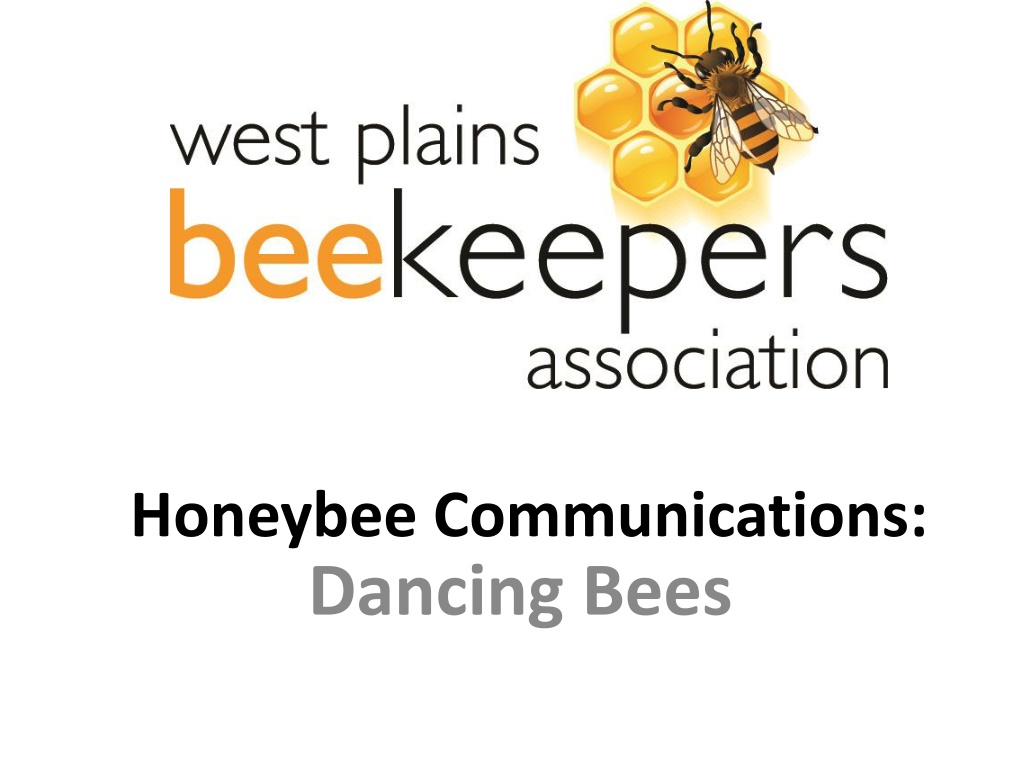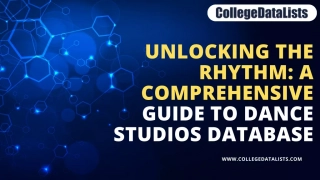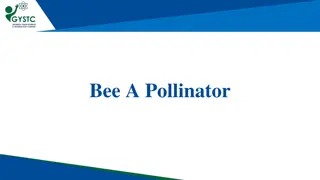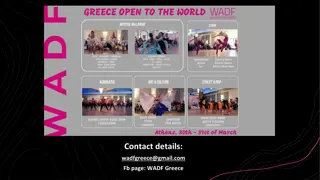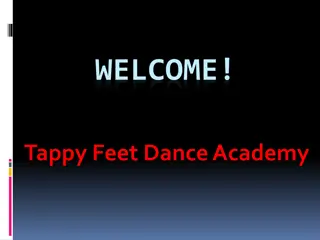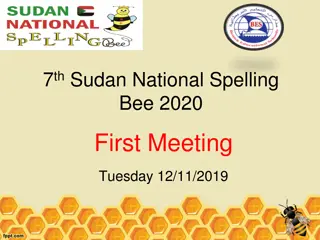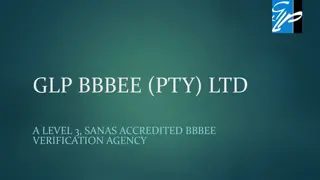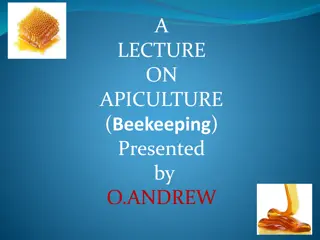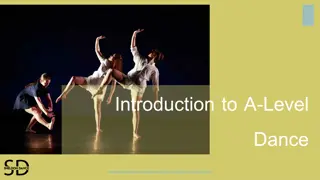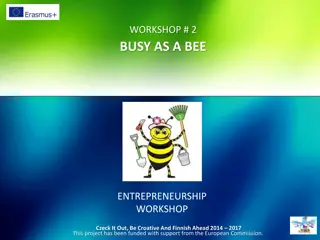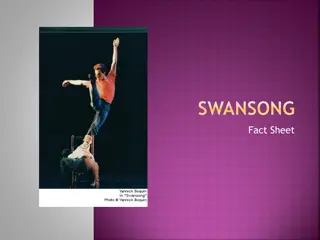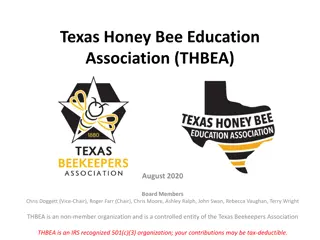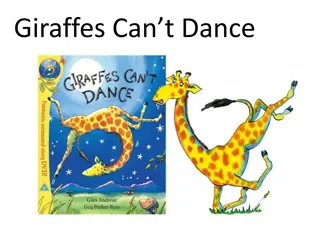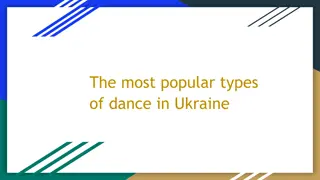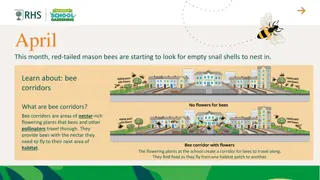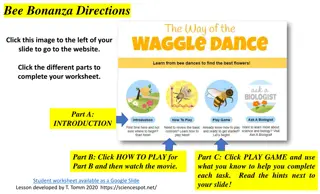Honeybee Communication through Dance: A Fascinating Look into Bee Behavior
Explore the intricate world of honeybee communication through dance, where bees convey information about food sources through different types of dances such as Round, Wagtail, and Sickle dances. The dialect variations among Carniolan, Italian, and Caucasian bees showcase how these tiny creatures adapt and communicate in unique ways to ensure the success of their hive. Discover the nuances in bee dancing related to nectar supply, scout bees, and the quality of food sources, shedding light on the remarkable intelligence and social communication within a bee colony.
Download Presentation

Please find below an Image/Link to download the presentation.
The content on the website is provided AS IS for your information and personal use only. It may not be sold, licensed, or shared on other websites without obtaining consent from the author. Download presentation by click this link. If you encounter any issues during the download, it is possible that the publisher has removed the file from their server.
E N D
Presentation Transcript
Honeybee Communications: Dancing Bees
Dance Communication - Introduction Kinds of Dances Round Dance Wagtail Dance Sickle Dance Where to Live Dance Dialects Carniolan Italian
The Round Dance Carniolan Dialect Food or Water <80 meters Several seconds to a minute Various places on the comb Liveliness -> Source Richness Samples
Wagtail Dance Carniolan Dialect Food or Water >80 meters Fuel to Source Direction to Source Samples Profitability of Source
Wagtail Dance Carniolan Dialect (cont.) The energy (fuel) needed to reach the source is a function of the length of time a 250Hz sound is produced during the waggle. Flight conditions such as head or tail winds are accounted for A second is very roughly 1000 meters Note: Root talks about turns in a 15 second period correlated to distance.
Wagtail Dance Carniolan Dialect (cont.) The direction to the food source is the straight line direction in relation to the sun, even if a obstacle prevents straight line flight. A waggle straight up the comb is a direction straight toward the sun and a waggle down the comb is a direction away from the sun. A waggle 30 degrees to the left of vertical is a direction 30 degrees to the left of the sun.
Sickle Dance Italian Dialect Food or Water Transition between Round and Wagtail Dance At 10 meters it resembles a Round Dance At 30 meters it resembles a Wagtail Dance
Nuances The more scout bees are dancing and the more often they dance is related to the quality (high sugar content) and quantity of the source. The dancing changes as the nectar supply changes.
Dialect Differences Carniolan bees do not do a Sickle Dance but change to the Wagtail Dance at about 90 meters. Italian and Caucasian bees change to the Wagtail Dance at about 40 meters The races use the same direction language but distance is wrongly interpreted.
Dialect Differences (cont.) Species Differ in Language Apis Cerana (Eastern Honey Bee) uses the Round Dance up 3 meters and the rhythm is much slower Apis dorsata (Giant Honey Bee) is closer to mellifera and uses the Round Dance up to 4 or 5 meters. Apis Florea (Dwarf Bee) Dances horizontally on the landing place with a slow rhythm.
Dialect Differences (cont.) Distance in Meters Comparison Race Carniolan Italian German Caucasian Egyptian Round 0-80 0-6 0-20 0-10 0-5 Sickle None 6-8 20 10 5 Wagtail 80-90 34-36 64-66 35 10-12
Directional Dance Accuracy Von Frisch Fan Experiment 24 8 2 3 3 0 0 Sources at 200 m and 15 degrees apart
Distance Dance Accuracy Von Frisch Step Experiment 4 0 5 17 F 30 12 2 0 2 500m 750m 1000m 1500m 2000m 2500m Food source at 750 m
Von Frisch Arguments As food is shifted from 2 to 100 meters and from Round to Wagtail Dance the accuracy of finding food improved. When the sun s position is blocked searching for food is random as is the direction of the Wagtail Dance. Detour experiments show that when a scout goes around an obstacle she supplies information on the direct path and recruits initially fly direct. If an experiment forces bees to walk to a food source the dancing gives information on energy expended.
Deciding Where to Live Factors 10 Gal in volume >= 15 ft off the ground, narrow defensible opening Seeley set up five boxes of different sizes. Four of the boxes were mediocre while one was a dream home. In 80 percent of the trials, the swarms chose the dream home.
Decision Making Principles honeybees use to make decisions Enthusiasm - A scout coming back from an ideal cavity will dance with passion, making 200 circuits or more and waggling violently all the way. But if she inspects a mediocre cavity, she will dance fewer circuits. Attention - Enthusiasm translates into attention. An enthusiastic scout will inspire more bees to go check out her site. And when the second-wave scouts return, they persuade more scouts to investigate the better site.
Decision Making (cont.) Principles honeybees use to make decisions Flexibility. Once a scout finds a site, she travels back and forth from site to hive. Each time she returns, she dances to win over other scouts. But the number of dance repetitions declines, until she stops dancing altogether. Seeley and his colleagues found that honeybees that visit good sites keep dancing for more trips than honeybees from mediocre ones. This decaying dance allows a swarm to avoid getting stuck in a bad decision. Even when a mediocre site has attracted a lot of scouts, a single scout returning from a better one can cause the hive to change its collective mind.
Decision Making (cont.) The Quorum Scouts purposefully ram one another head-on while deciding on a new nest location. They head- butt scouts coming from other locations causing the rammed bee to stop dancing. As more scouts dance for a popular site, they drive down the number of dancers for other sites. Once the scouts reach a quorum of 15 bees all dancing for the same location, they start to head- butt one another, silencing their own side so that the swarm can prepare to fly.
Bibliography ABC and XYZ of Bee Culture by A.I. Root Honey Bee Biology and Beekeeping by Dewey M. Caron Honeybee Democracy by Thomas D. Seeley
